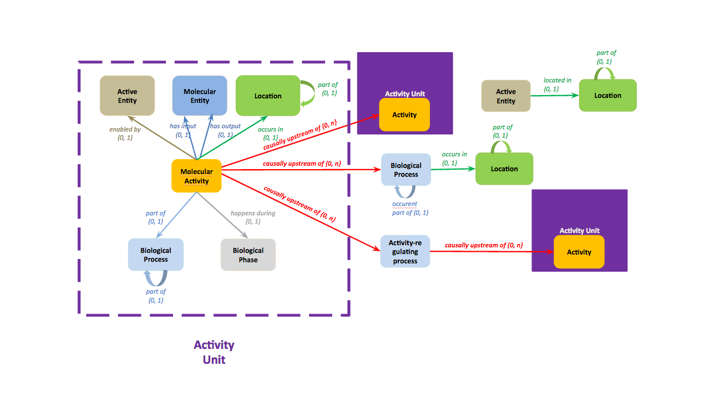GO-CAM Overview and Curation Strategy
GO-CAM Principles
GO-CAMs are biological process-centric models: models in which one main process is represented by causal relationships between the molecular functions that are an integral ‘part of’ of the process.
The basic unit of a GO-CAM model is the Activity Unit which represents a set of standard GO annotations with select annotation extensions, e.g. the inputs and outputs of a molecular function. GO-CAM models are constructed by filling in as many pieces of relevant information in an Activity Unit as possible and then linking, using Relations Ontology relations, different Activity Units in a causal chain to model a biological process. External ontology terms may be used to clarify how a gene functions in the broader context of a biological process or pathway.

Biological processes can be nested in process-centric models but generally should be used to link subprocesses to larger processes rather than to link several larger processes within one GO-CAM. For example, gene expression processes, such as positive regulation of transcription, may be included in a model of a signaling pathway, but intestine development would not be in the same model as digestion. Note, however, that it is not necessary to include the full causal model for gene expression subprocesses in a model of a larger process.
Separate models are made for a biological process and regulation of that process.
Suggested Workflow
It can be very helpful to refer to a summary figure from a recent research article or review to help visualize a potential GO-CAM.
- When making a biological process-centric GO-CAM model, we suggest these steps:
- What are the main activities (MFs) of each of the gene products in a model?
- How do those activities relate, in a causal chain, to each other?
- What processes are those activities involved in?
- Where do the activities occur?
Paper-centric and gene-centric curation are two other approaches to GO curation that can produce ‘building block’ annotations for GO-CAMs.
When annotating a single paper, try to incorporate as much of the suggested workflow as possible. This will make it easier, in the future, to build on existing models with new curation.
Review Status
Last reviewed:
Reviewed by: